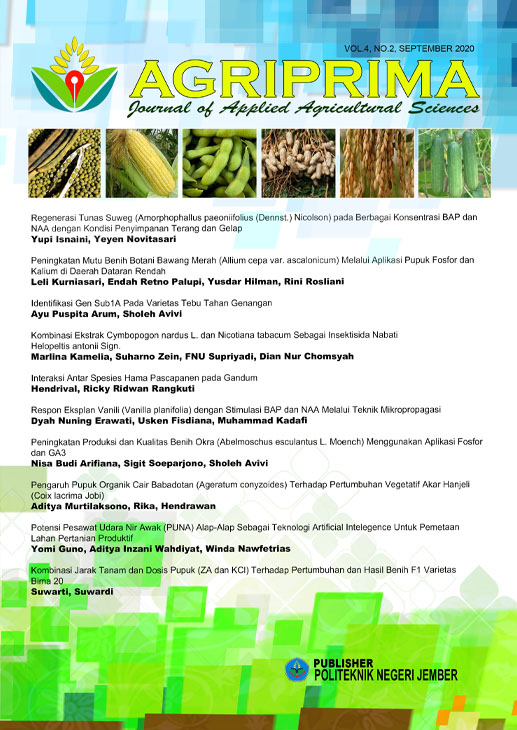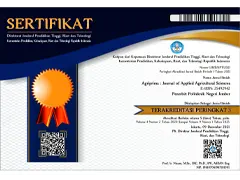Abstract
Tebu dapat tumbuh pada berbagai kondisi lingkungan yang cukup beragam termasuk pada lahan marginal seperti lahan yang sering tergenang. Lahan tergenang dapat menurunkan produksi tebu cukup signifikan. Tujuan penelitian ini adalah menemukan gen toleran kebasahan yang terdapat pada 8 varietas unggul komersial tebu yang tahan genangan yaitu PS 881, PS 862, PS 882, Kentung, PSJT 941, Bulu Lawang, PS 865 dan Kidang Kencana serta mengidentifikasi kemiripannya dengan gen Sub1A. Dengan diperolehnya gen toleran kebasahan pada varietas tebu tahan genangan di harapkan varietas tebu tersebut dapat ditanam di lahan yang sering tergenang dan dapat memberikan tambahan sumbangan produksi gula secara Nasional. Sehingga pada akhirnya dapat mengurangi impor yang secara kontinu dilakukan pemerintah setiap tahun dan sebagai solusi peningkatan produksi pangan berbasis lahan daratan dalam menghadapi perubahan iklim. Tahapan untuk memperoleh dan mengidentifikasi gen toleran kebasahan atau tahan genangan adalah pengkondisian lahan tanaman tebu tergenang, isolasi DNA dari tanaman tebu yang tergenang, penentuan konsentrasi dan kemurnian DNA yang diperoleh, konfirmasi DNA yang diisolasi dengan elektroforesis dan identifikasi gen Sub 1 A pada DNA sampel metode PCR dengan primer Sub 1 A 203 R/F dan kontrol Positif DNA tanaman padi transgenik yang mengandung gen Sub 1 A. Hasil kegiatan penelitian dapat disimpukan bahwa 8 varietas unggul komersial tebu yaitu PS 881, PS 862, PS 882, Kentung, PSJT 941, Bulu Lawang, PS 865 dan Kidang Kencana semuanya mempunyai gen yang mirip dengan gen Sub 1 A. Dengan varietas PS 881 dan Kentung menghasilkan band sekuens DNA target gen Sub 1 A paling tebal.
Keywords:
Genangan Gen Sub1A Identifikasi gen Sub1AReferences
Armstrong, W. (2002). Root growth and metabolism under oxygen deficiency. Plant Roots: The Hidden Half, 729–761.
Avivi, S., Syamsunihar, A., Soeparjono, S., & Chozin, M. (2018). Toleransi Berbagai Varietas Tebu terhadap Penggenangan pada Fase Bibit Berdasarkan Karakter Morfologi dan Anatomi Tolerance of Sugarcane Varieties toward Waterlogging at Seedling Stage based on Morphological Characteristics and Anatomy. 46(April), 103–110.
Banayo, N. P. M., Mabesa-Telosa, R. C., Singh, S., & Kato, Y. (2019). Improved early season management of sub1 rice varieties enhances post-submergence recovery and yield. Experimental Agriculture, 55(1), 105.
Begum, M. K. (2003). Effects of Water-Logging on Juice Quality and Yield of Sugarcane. Stress physiology View project. Article in Pakistan Journal of Biological Sciences, 6(13), 1151–1155.
Chalmers, K. J. (1994). Detection of genetic diversity and selective gene introgression in coffee using RAPD markers The effect of Zebularine on Recombination in Barley View project Barley View project. Springer, 87(8), 934–940.
Cheng, Y.-J., Guo, W.-W., Yi, H.-L., Pang, X.-M., & Deng, X. (2003). An efficient protocol for genomic DNA extraction fromCitrus species. Plant Molecular Biology Reporter, 21(2), 177–178.
Fukao, T., & Bailey-Serres, J. (2008). Submergence tolerance conferred by Sub1A is mediated by SLR1 and SLRL1 restriction of gibberellin responses in rice. Proceedings of the National Academy of Sciences, 105(43), 16814–16819.
Galuh Permana, D., Soegianto, A., & Kuswanto, D. (2018). Respon Enam Varietas Unggul Tebu Terhadap Genangan The Response Of Six Superior Sugarcane Varieties Again Flood. Jurnal Produksi Tanaman, 6(6), 1195–1203.
Glaz, B., Morris, D. R., & Daroub, S. H. (2004). Periodic flooding and water table effects on two sugarcane genotypes. Agronomy Journal, 96(3), 832–838.
Gusmiatun, G., Palembang, U. M., Suwignyo, R. A., Sriwijaya, U., Wijaya, A., Sriwijaya, U., & Hasmeda, M. (2015). Peningkatan Toleransi Rendaman Padi Lokal Rawa Lebak dengan Introgresi Gen Sub1. (May 2017). https://doi.org/10.24831/jai.v43i2.10409
Hoque, E., & Ability, C. (2017). Expression of SUB1 gene in relation with different submergence tolerance mechanisms in rice ( Oryza sativa L .).
Mackill, D. J., Ismail, A. M., Singh, U. S., Labios, R. V, & Paris, T. R. (2012). Development and rapid adoption of submergence-tolerant (Sub1) rice varieties. In Advances in agronomy (Vol. 115, pp. 299–352). Elsevier.
Murtiyaningsih, H., Pertanian, F., & Jember, U. M. (n.d.). Isolasi DNA Genom dan Identifikasi Kekerabatan Genetik Nanas Menggunakan RAPD (Random Amplified Polimorfic DNA) [DNA Genom Isolation And Identification Of Genetic Relationship Pineapple Usingrapd (Random Amplified Polimorfic DNA)]. In jurnal.unmuhjember.ac.id.
Perata, P., & Voesenek, L. A. C. J. (2007). Submergence tolerance in rice requires Sub1A, an ethylene-response-factor-like gene. Trends in Plant Science, 12(2), 43–46.
Permana, D. G., Winarsih, S., Soegianto, A., & Kuswanto, K. (2018). Respon Enam Varietas Unggul Tebu Terhadap Genangan. Jurnal Produksi Tanaman, 6(6).
Ramadhan, R. (n.d.). Studi Pertumbuhan Tanaman Tebu Toleran Cekaman Air Berdasarkan Karakter Fisiologisnya. In repository.unej.ac.id.
Santos, R. S., Krüger, M. M., Pegoraro, C., Madabula, F. P., Maia, L. C., Rombaldi, C. V., & de Oliveira, A. C. (2013). Transcriptional regulation of seven ERFs in rice under oxygen depletion and iron overload stress. Tropical Plant Biology, 1(6), 16–25.
Schreinert, R., Farias, R., Pegoraro, C., Rombaldi, C. V., Fukao, T., Wing, R. A., & Oliveira, A. C. De. (2017). Evolutionary analysis of the SUB1 locus across the Oryza genomes. 3–7.
Septiningsih, E. M., Pamplona, A. M., Sanchez, D. L., Neeraja, C. N., Vergara, G. V., Heuer, S., … Mackill, D. J. (2009). Development of submergence-tolerant rice cultivars: the Sub1 locus and beyond. Annals of Botany, 103(2), 151–160.
Statistik, B. S.-J. (ID): B. P., & 2015, undefined. (n.d.). Statistik Tebu Indonesia.
Syahfitri, A., Staf, H., Program, P., & Agroekoteknologi, S. (2017). Uji Kualitas Dan Kuantitas Dna Beberapa Populasi Pohon Kapur Sumatera. In jurnal.pancabudi.ac.id.
Tetsushi, H., Studies, M. K.-S. P., & 2007, undefined. (n.d.). Flooding tolerance of sugarcane in relation to growth, physiology and root structure. In ir.kagoshima-u.ac.jp.
Tiwari, D. N. (2018). A Critical Review of Submergence Tolerance Breeding beyond Sub 1 Gene to Mega Varieties in the Context of Climate Change. (March).
Xu, K., & Mackill, D. J. (n.d.). A Microsatellite Marker and A Codominant PCR-Based Marker For Marker-Assisted Selection of Submergence Tolerance in Rice Implementation Plans to Disseminate Submergence Tolearnt Rice Varieties And Associated Production Practices To Souteastasia View Project. Wiley Online Library.
License
Copyright (c) 2020 Ayu Puspita Arum, Sholeh Avivi

This work is licensed under a Creative Commons Attribution-ShareAlike 4.0 International License.
You are free to:
- Share — copy and redistribute the material in any medium or format.
- Adapt — remix, transform, and build upon the material for any purpose, even commercially.
Under the following terms:
- Attribution — You must give appropriate credit, provide a link to the license, and indicate if changes were made. You may do so in any reasonable manner, but not in any way that suggests the licensor endorses you or your use.
- ShareAlike — If you remix, transform, or build upon the material, you must distribute your contributions under the same license as the original.
- No additional restrictions — You may not apply legal terms or technological measures that legally restrict others from doing anything the license permits.









